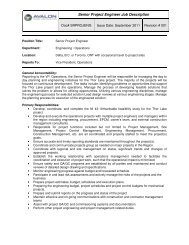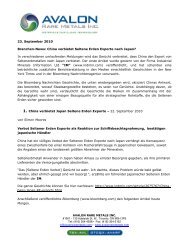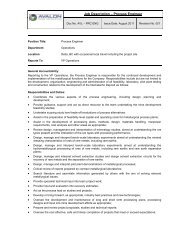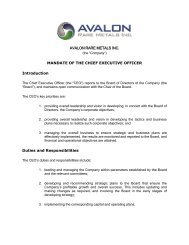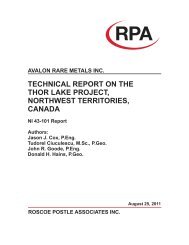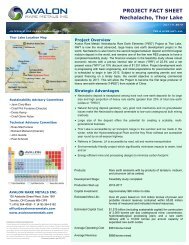technical report on the nechalacho deposit, thor lake project ...
technical report on the nechalacho deposit, thor lake project ...
technical report on the nechalacho deposit, thor lake project ...
Create successful ePaper yourself
Turn your PDF publications into a flip-book with our unique Google optimized e-Paper software.
The crushing plant is designed for <strong>the</strong> expansi<strong>on</strong> t<strong>on</strong>nage. The grinding circuit will require <strong>the</strong><br />
additi<strong>on</strong> of a sec<strong>on</strong>d ball mill to handle <strong>the</strong> expansi<strong>on</strong> t<strong>on</strong>nage. Additi<strong>on</strong>al flotati<strong>on</strong> cells, gravity<br />
separati<strong>on</strong> units and filters will also be needed.<br />
In <strong>the</strong> proposed operati<strong>on</strong>, full c<strong>on</strong>centrate c<strong>on</strong>tainers are stored at <strong>the</strong> hydrometallurgical<br />
facility and retrieved and placed in a thaw shed as required. The c<strong>on</strong>centrate is thawed and<br />
<strong>the</strong>n dumped into reclaim system that c<strong>on</strong>veys <strong>the</strong> material into <strong>the</strong> hydrometallurgical plant.<br />
C<strong>on</strong>centrate is “cracked” using a combinati<strong>on</strong> of acid baking, caustic cracking, and leaching<br />
using sulphuric acid and sodium hydroxide as <strong>the</strong> primary reagents.<br />
The solid residue from <strong>the</strong> cracking system is combined with o<strong>the</strong>r waste streams and sent to<br />
<strong>the</strong> hydrometallurgical tailings storage facility. The soluti<strong>on</strong> arising from <strong>the</strong> cracking process is<br />
subjected to double salt precipitati<strong>on</strong>, soluti<strong>on</strong> pre-treatment and solvent extracti<strong>on</strong> processes to<br />
isolate <strong>the</strong> values. Products are precipitated as basic salts, processed and dried to yield<br />
hydrated oxides which are packaged for shipment to markets. Products are be trucked to Hay<br />
River for <strong>on</strong>-shipment by rail.<br />
The proposed hydrometallurgical process plant c<strong>on</strong>sumes a significant quantity of reagents<br />
which will be brought to site by rail to Hay River and <strong>the</strong>n by truck to <strong>the</strong> plant. Sulphuric acid is<br />
to be produced in a 700 tpd capacity double-c<strong>on</strong>tact, double absorpti<strong>on</strong> plant from elemental<br />
sulphur. Excess heat from <strong>the</strong> sulphuric acid plant is used in <strong>the</strong> hydrometallurgical process in<br />
<strong>the</strong> thaw shed, to evaporate process soluti<strong>on</strong>s, and in <strong>the</strong> product driers.<br />
Limest<strong>on</strong>e is quarried near Enterprise and crushed and ground to -44 µm for use as a<br />
neutralizing reagent in <strong>the</strong> process. Some limest<strong>on</strong>e is calcined to lime for neutralizing<br />
purposes.<br />
O<strong>the</strong>r reagents, such as sodium hydroxide, fuel, solvent extracti<strong>on</strong> reagents, etc. are stored at<br />
site as needed.<br />
Most of <strong>the</strong> hydrometallurgical complex, including <strong>the</strong> acid plant, is designed and c<strong>on</strong>structed for<br />
<strong>the</strong> ultimate t<strong>on</strong>nage equivalent to 2,000 tpd of flotati<strong>on</strong> c<strong>on</strong>centrate. Units requiring duplicati<strong>on</strong><br />
or additi<strong>on</strong> for <strong>the</strong> expansi<strong>on</strong> t<strong>on</strong>nage include <strong>the</strong> thaw shed, acid bake and caustic cracking<br />
facilities, and some of <strong>the</strong> product driers.<br />
PROCESS DESIGN CRITERIA<br />
The principal design criteria selected for <strong>the</strong> pre-feasibility study are tabulated in Table 18-12.<br />
The flowsheet used as <strong>the</strong> basis for flotati<strong>on</strong> recoveries used in <strong>the</strong> PFS is shown in Figure 18-8<br />
and <strong>the</strong> flowsheet used as <strong>the</strong> basis for hydrometallurgical recoveries used in <strong>the</strong> PFS is shown<br />
in Figure 18-9.<br />
Technical Report 43-101 – March 13, 2011 Page 18-36<br />
Prepared by Aval<strong>on</strong> Rare Metals Inc.






